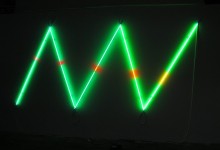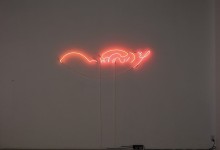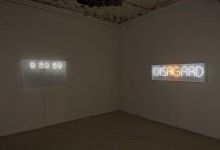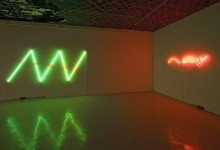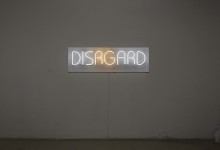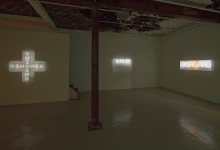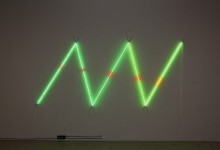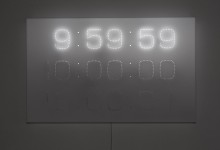Orest Tataryn: Thought Sculpture
Word Play in Colour Fields
Neon as a medium brings with it the incredible weight of its commercial history. It is difficult to think about neon without thinking of flashing late-night advertisements on city streets. Bringing such a medium into artistic practice requires sensitivity in order to separate the different levels of representation at work (or at play) within it. Over the past 6 years of his solo artistic practice, artist Orest Tataryn has explored colour, text and form in neon. In this most recent iteration of his work, Tataryn has left aside his shaping of form using marbled Venetian glasswork and committed himself to focusing more on the interplay of text and colour to further bring neon into the realm of artistic expression.
Tataryn has played with text in his previous projects, such as Ornament/Armament (2007), Mother Nurture/Murder Nature (2007) and Whites Only (2006). His spoonerisms harken the wry and clever wordplay of Bruce Nauman in such pieces as Violins Violence Silence (1981-82), Run from Fear, Fun from Rear (1972) and None Sign, Neon Sign (1970). Whites Only, however, stands out. The sign, making reference to a racially segregated past, subtly, slyly and powerfully plays with meaning by varying the shades of white used within the sign itself, implying that the whites it refers to have nothing to do whatsoever with any charged racial significance.
What differentiates Tataryn from Nauman is his sensitivity to the variation in and effects of colour. The colours he uses in neon are unusual, divorcing the medium from its commercial past through unexpected chromatic engagement.
In this current show, Tataryn’s early work with colour fields (reminiscent of Dan Flavin and James Turrell) has been transformed into explorations of colour through text. His piece jaune takes up where Whites Only left off, playing with variations in yellow. The work envy further plays with common idiom, ensconcing an N and V in close proximity in different shades of green.
Beyond light and shadow, Tataryn effectively plays with perception and cognition to bring neon into the realm of artistic consideration. The Toronto-based light sculptor also plays with the shapes that text creates, deforming meaning and legibility in order to produce aesthetic studies of form. Misspellings, symmetries, and textual repetitions and manipulations create a cognitive dissonance that forces the viewer to engage purely on a visual level. Form trumps meaning in ohio christ, where the word and its possible meaning falls away to the glowing symmetry of an orthodox-style cross. Misspelling in regard has the viewer searching for the missing letter.
Ultimately, Tataryn pushes neon into a more artistic realm. Bringing together a cognitive engagement with a sense of play, the neon artist showcases the potent beginnings of an exploration of text and colour.


